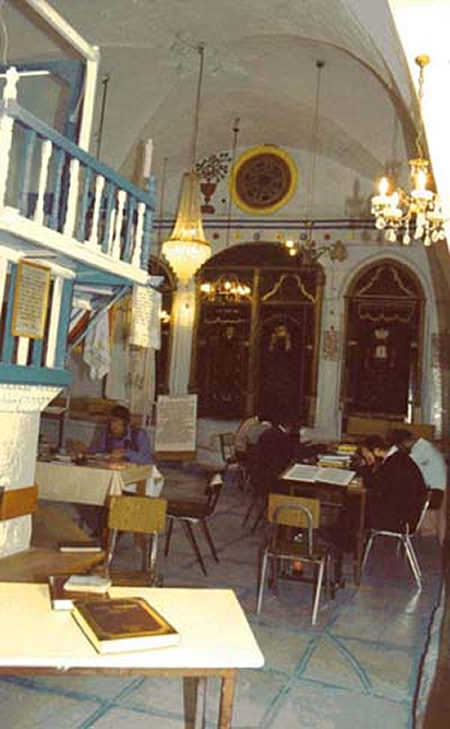Chana Katz
If you ask someone how to get to the Ari synagogue, you might get asked back: “The real Ari synagogue?” With two synagogues in Tzfat (Safed) bearing the name of the holy Ari — Rabbi Isaac Luria, only one, the Ari Sephardic Synagogue is where the Ari himself learned and prayed. The other, the Ari Ashkenzic Synagogue, was built two centuries after the Ari’s brief but powerful mystical sojourn in Tsfat.
Charming Walk
To reach the 700-year-old Ari Sephardic Synagogue — and behold its intricate, mystical craftsmanship and holy secrets — one can follow winding HaAri Street right from Ascent to the synagogue’s original arched entranceway.
The ten-minute walk winds past charming, old stone houses on one side and an uninhibited view of the hushed valley which leads to hovering Mount Meron on the other, giving one the solitude and serenity to think about the days when the holy Ari sat on a stone slab inside one of the synagogue’s anterooms and was said to have learned the most mystical, deepest teachings of the Torah from Elijah the Prophet himself.
As the wind rustles through the tall olive and pine trees, the visitor can look down to his right and see the graves from the “Old” cemetery of Tzfat, where the Holy Ari and many of his famous associates and disciples are buried.
The Caretakers
In no time you’re standing in front of a large, two-story stone building, looking at its arched stained glass windows. The synagogue actually was built in 1301, nearly three centuries before the Ari came to Tzfat, and it was originally called the Eliyahu HaNavi (Elijah’s) Synagogue. In the “Golden Age” of the kabbalists in the middle 1500’s, it was the most important of Tzfat’s seventy synagogues.
Climbing about a dozen stairs to the stone courtyard with its two ripe-old trees, one can hear voices of a rabbi and his student who study Torah in a side room every day, their tables piled high with ancient books, their voices carrying loudly as they discuss intricate details from the day’s learning.
[photo courtesy of www.thirdtemple.com]
Their small “kollel” is — perhaps sadly — all that is left of the weekday activity at the ancient synagogue. Except for Shabbat and Festival services, the main sanctuary of the synagogue is locked. There is, simply, not enough money or participants to keep the splendid synagogue open for daily services, as there are no longer any houses (with the exception of the new Bretzlav community) in this isolated area near the cemetery at the bottom of the Old City.
But if one is lucky — as Divine Providence would have it — he or she can come across one of the synagogue’s members who will be happy to share some of its secrets and history.
Earthquakes
Like many of Tsfat’s ancient sites, the four powerful earthquakes which jolted and devastated much of this town left their mark on the Ari Synagogue. But unlike some of the other synagogues which were all but completely destroyed, this synagogue was miraculously spared from major damage, except for portions of its western wall.
The importance of this is that a visitor can actually view the synagogue as it has stood for more than seven centuries, with only the modern renovations restoring the site as closely as possible to the original.
The Holy Room
Perhaps the most revered spot in the Ari Synagogue is a small room just left of the bima as you enter, where it is said that the Ari — and only the Ari — was visited by Elijah the Prophet, who revealed to him the finest of fruits from the deepest, hidden orchards of the Torah.
“Take these two candles and light them in that room,” says one of the synagogue’s members who happened to be there when a visitor arrived. “It is a segulah to light the candle there and ask (pray) for what you want.”
It is said of this special room – and some say of the shul itself — that there was a time when one who entered it would die, until the noted Sephardic rabbi and kabbalist known as Baba Sali entered the room and through his spiritual powers was able to effect a change so that all could safely enter. (For the full story, click here.)
Intricate Designs
The synagogue appears to have been designed with the lofty kabbalistic concepts of the Torah in mind. For example, while most modern synagogues have one “Aron HaKodesh” — holy ark — where the Torah scrolls are stored, here at the Ari, there are four.
Why? Because of the kabbalistic connection to the four letters of the holy name of G-d by which Jews call to Him in their prayers. The finely detailed carvings around each ark show exquisite details rarely found in today’s workmanship.
Directly above the middle ark is a round stained glass window that is said to be the original.
Nor is it coincidence that the floors are large white marble blocks bordered by that special “Tzfat blue.” According to kabbalah, the earth is signified by the color white, and the heavens by the color blue.
The platform from where the Torah is read is much higher than in modern synagogues, requiring one to walk up six steps — each step signifying one of the regular weekdays. The reader stands at the seventh level — just as on the seventh day, the Sabbath, we come to rest. Look closely under each of the stairs leading up to the bima and you will notice intricate wood craftsmanship.
The bima is located in the center of the large rectangular shul. Cushioned seats on a stone ledge surround the outer wall of the synagogue, a stark contrast from the rows of seats found in Ashkenazic synagogues.
The Well
One of the more interesting features of this synagogue is an ancient well which was dug next to the bima when the synagogue was first built. It’s seven hundred years old, but if you are lucky to find someone to unlock the wood covering over the well, you will see that it still is filled with water.
Although the 16-meter deep by three-meter-wide well was used in days of old to provide water for ritual hand washing and other needs, it is almost ironic that the well, which is said to draw its water directly from the Ari’s mikveh, cannot be used today. That is because the synagogue owes the local government some 12,000 shekels in unpaid water bills. At one point the city even shut off the synagogue’s water but after enough protests, it was restored — debt unpaid.
Antique-Lover’s Dream
While in some ways the synagogue has become thoroughly modern — such as its installation of an air conditioning/heating system in 1995, there are other features of this synagogue that will dazzle antique lovers. One standout is the oversized wooden chair used during a brit milah (ritual circumcision). Beautifully carved and preserved, the chair is connected by two planks to a wooden crib that was just the right size for the infant.
Bye For Now
Although the Ari Sephardic Synagogue is almost too quiet today, the splendor and holiness of this synagogue hasn’t diminished one drop — almost as if it’s waiting for the lively days of yore to be flowing with new life again.
Buy books about Safed and the ancient masters of Kabbalah at the Kabbala Online Shop.
Chana Katz, a former South Florida journalist, lives in Tsfat. Her articles on life in Israel have reached publications throughout the world.

